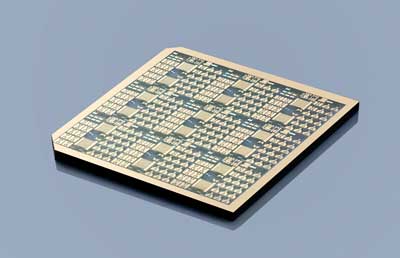| Aug 28, 2019 | |
Energy-efficient power electronics - gallium oxide power transistors with record values(Nanowerk News) Powerful electronic components are indispensable for future communications, for the digital transformation of society and for artificial intelligence applications. On a footprint as small as possible, they should offer low energy consumption and achieve ever higher power densities, thus working more efficiently. This is where conventional devices reach their limits. |
|
| Scientists all over the world are therefore investigating new materials and components that can meet these requirements. The Ferdinand-Braun-Institut (FBH) has now achieved a breakthrough with transistors based on gallium oxide (β-Ga2O3). | |
 |
|
| Gallium oxide chip with transistor structures and structures for measurement purposes, manufactured at Ferdinand-Braun-Institut using projection lithography. (Image: Ferdinand-Braun-Institut /schurian.com) | |
| The newly developed β-Ga2O3-MOSFETs (metal-oxide-semiconductor field-effect transistor) provide a high breakdown voltage combined with high current conductivity. With a breakdown voltage of 1.8kilovolts and a record power figure of merit of 155megawatts per square centimeter, they achieve unique performance figures close to the theoretical material limit of gallium oxide. | |
| At the same time, the breakdown field strengths achieved are significantly higher than those of established wide bandgap semiconductors such as silicon carbide or gallium nitride. | |
Optimized layer structure and gate topology |
|
| In order to achieve these improvements, the FBH team tackled the layer structure and gate topology. The basis was provided by substrates from the Leibniz-Institut für Kristallzüchtung with an optimized epitaxial layer structure. | |
| As a result, the defect density could be reduced and electrical properties improved. This leads to lower on-state resistances. The gate is the central ‘switching point’ of field effect transistors, controlled by the gate-source voltage. Its topology has been further optimized, allowing to reduce high field strengths at the gate edge. This in turn leads to higher breakdown voltages. | |
| The detailed results were published in the IEEE Electron Device Letters ("Lateral 1.8 kV β-Ga2O3 MOSFET With 155 MW/cm2 Power Figure of Merit"). |
| Source: Forschungsverbund Berlin | |
|
Subscribe to a free copy of one of our daily Nanowerk Newsletter Email Digests with a compilation of all of the day's news. |
